MBA Report: Exploring Theories of Innovation and Change Management
VerifiedAdded on 2023/05/28
|10
|3402
|240
Report
AI Summary
This report provides an overview of theories and models related to innovation and change management within organizations. It begins by defining innovation and its importance, referencing key thinkers such as Mulgan, Albury, Van de Ven, and Schumpeter, and discussing different types of innovation, including product, process, position, and paradigm innovations. The report explores the basic models of innovation, emphasizing the role of creativity and the importance of a supportive organizational culture. It then delves into the implementation aspects of innovation, highlighting the risks involved and the factors influencing the adoption of innovation. The report further examines incremental and disruptive innovation, as well as the innovation process, including idea generation, opportunity selection, implementation, and capture. Additionally, it discusses the importance of rethinking assumptions, reconfiguring operations, and other strategies to drive innovation. The report also covers various change models, including Porter's leadership change model, Lewin's model (unfreezing, transforming, and freezing), and Kotter's model, emphasizing the importance of employee commitment, understanding, and a clear vision for successful change management. Finally, the report touches upon the theories of Beer and Noria, highlighting the significance of stakeholder involvement and the use of structure and framework to achieve organizational change.
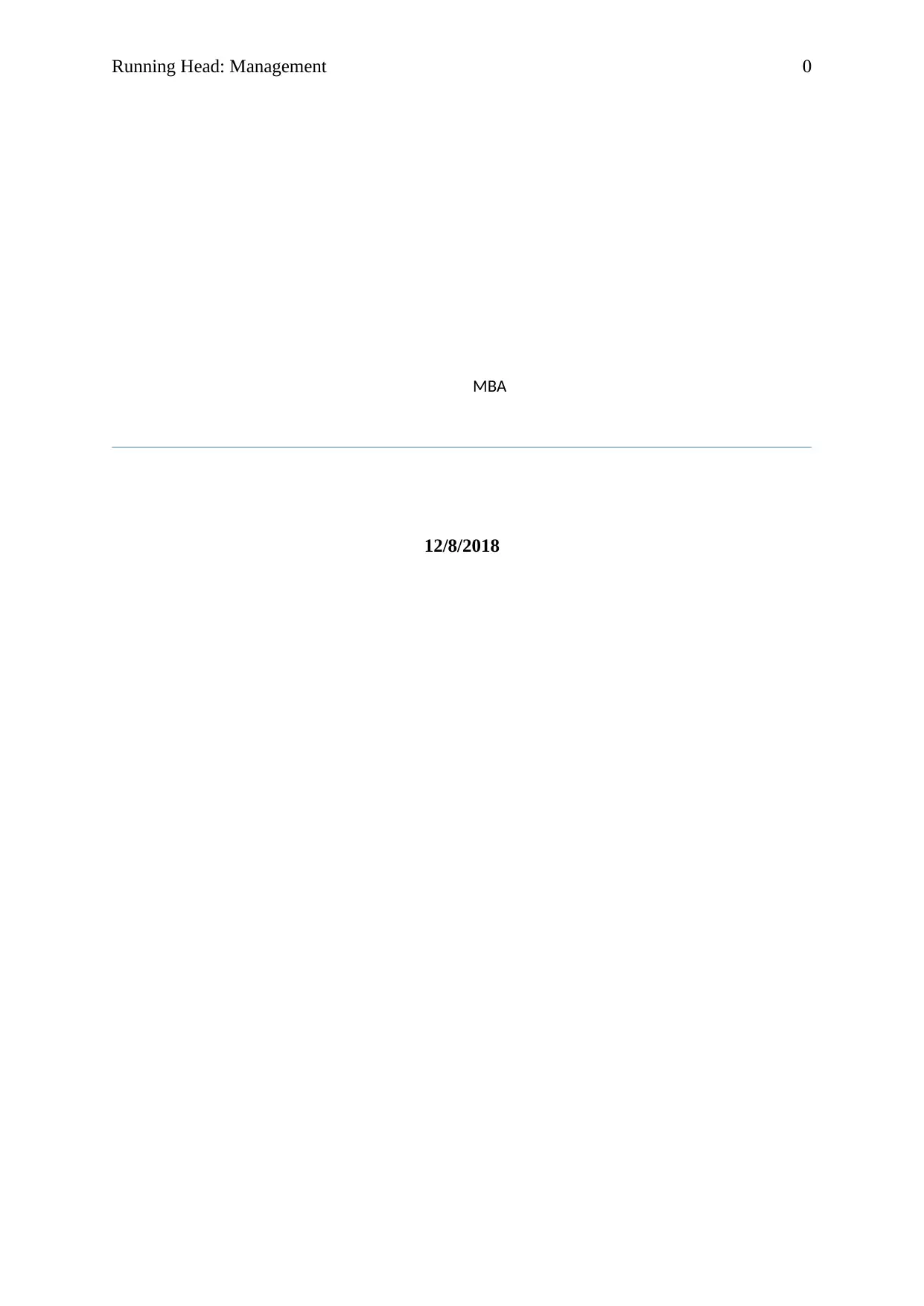
Running Head: Management 0
MBA
12/8/2018
MBA
12/8/2018
Paraphrase This Document
Need a fresh take? Get an instant paraphrase of this document with our AI Paraphraser
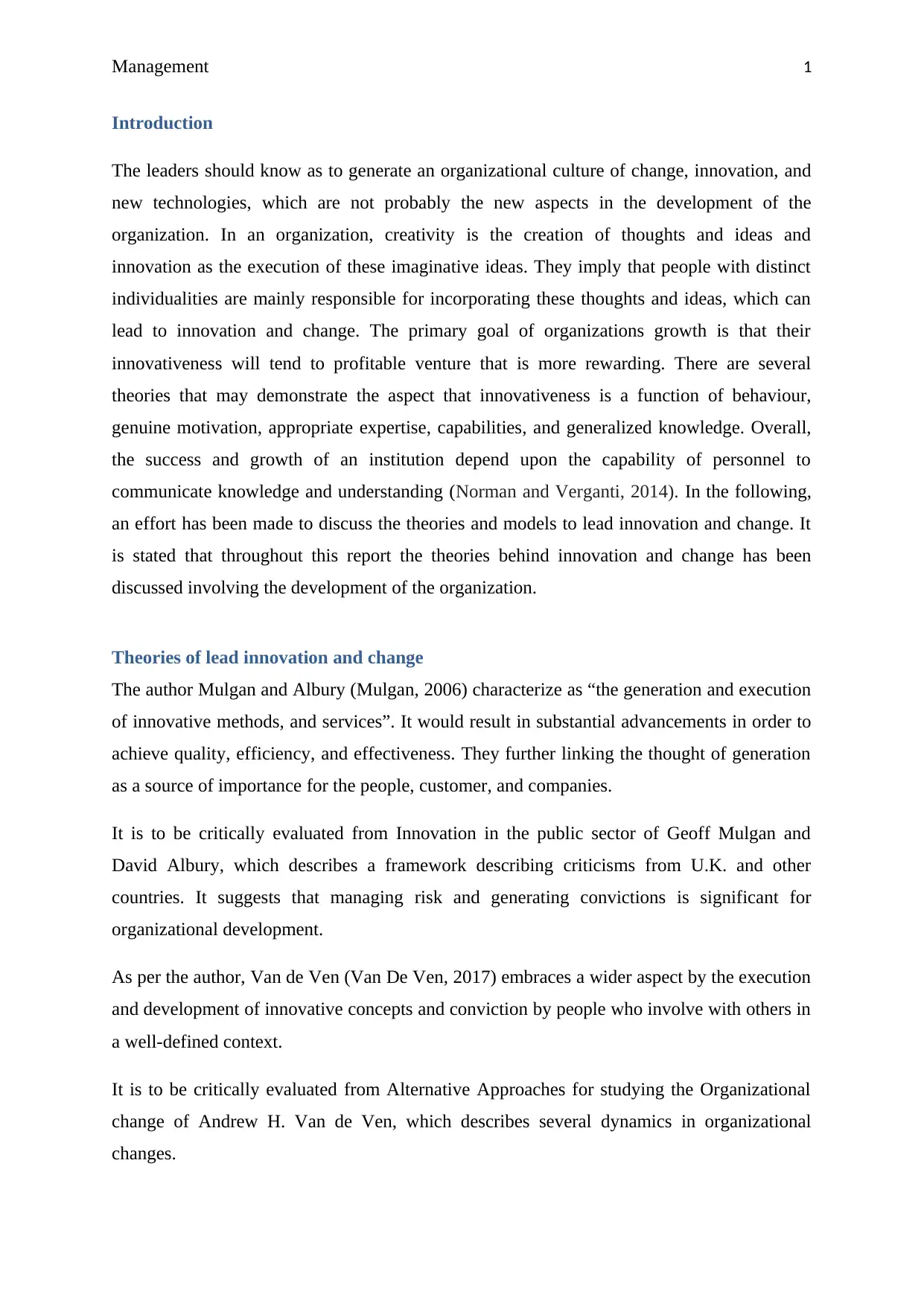
Management 1
Introduction
The leaders should know as to generate an organizational culture of change, innovation, and
new technologies, which are not probably the new aspects in the development of the
organization. In an organization, creativity is the creation of thoughts and ideas and
innovation as the execution of these imaginative ideas. They imply that people with distinct
individualities are mainly responsible for incorporating these thoughts and ideas, which can
lead to innovation and change. The primary goal of organizations growth is that their
innovativeness will tend to profitable venture that is more rewarding. There are several
theories that may demonstrate the aspect that innovativeness is a function of behaviour,
genuine motivation, appropriate expertise, capabilities, and generalized knowledge. Overall,
the success and growth of an institution depend upon the capability of personnel to
communicate knowledge and understanding (Norman and Verganti, 2014). In the following,
an effort has been made to discuss the theories and models to lead innovation and change. It
is stated that throughout this report the theories behind innovation and change has been
discussed involving the development of the organization.
Theories of lead innovation and change
The author Mulgan and Albury (Mulgan, 2006) characterize as “the generation and execution
of innovative methods, and services”. It would result in substantial advancements in order to
achieve quality, efficiency, and effectiveness. They further linking the thought of generation
as a source of importance for the people, customer, and companies.
It is to be critically evaluated from Innovation in the public sector of Geoff Mulgan and
David Albury, which describes a framework describing criticisms from U.K. and other
countries. It suggests that managing risk and generating convictions is significant for
organizational development.
As per the author, Van de Ven (Van De Ven, 2017) embraces a wider aspect by the execution
and development of innovative concepts and conviction by people who involve with others in
a well-defined context.
It is to be critically evaluated from Alternative Approaches for studying the Organizational
change of Andrew H. Van de Ven, which describes several dynamics in organizational
changes.
Introduction
The leaders should know as to generate an organizational culture of change, innovation, and
new technologies, which are not probably the new aspects in the development of the
organization. In an organization, creativity is the creation of thoughts and ideas and
innovation as the execution of these imaginative ideas. They imply that people with distinct
individualities are mainly responsible for incorporating these thoughts and ideas, which can
lead to innovation and change. The primary goal of organizations growth is that their
innovativeness will tend to profitable venture that is more rewarding. There are several
theories that may demonstrate the aspect that innovativeness is a function of behaviour,
genuine motivation, appropriate expertise, capabilities, and generalized knowledge. Overall,
the success and growth of an institution depend upon the capability of personnel to
communicate knowledge and understanding (Norman and Verganti, 2014). In the following,
an effort has been made to discuss the theories and models to lead innovation and change. It
is stated that throughout this report the theories behind innovation and change has been
discussed involving the development of the organization.
Theories of lead innovation and change
The author Mulgan and Albury (Mulgan, 2006) characterize as “the generation and execution
of innovative methods, and services”. It would result in substantial advancements in order to
achieve quality, efficiency, and effectiveness. They further linking the thought of generation
as a source of importance for the people, customer, and companies.
It is to be critically evaluated from Innovation in the public sector of Geoff Mulgan and
David Albury, which describes a framework describing criticisms from U.K. and other
countries. It suggests that managing risk and generating convictions is significant for
organizational development.
As per the author, Van de Ven (Van De Ven, 2017) embraces a wider aspect by the execution
and development of innovative concepts and conviction by people who involve with others in
a well-defined context.
It is to be critically evaluated from Alternative Approaches for studying the Organizational
change of Andrew H. Van de Ven, which describes several dynamics in organizational
changes.

Management 2
As per the Joseph Schumpeter (Schumpeter, 2017), it is a diverse form of the invention as it
associated with technological advancement while innovation relies upon marketing and
acceptance. Additionally, it stresses the importance of innovation for economic success and
development. Through the different definitions, innovation can be précised as a generation,
whose understanding would create corporate opportunities in order to meet existing and new
needs and preferences.
Through Schumpeter (Schumpeter, 2017), it is discovered the five main types of innovation: -
The invention of an innovative product;
The commencement of a process of operation;
The starting of an industry;
The commencement of a new organization;
Tidd and Bessant (Bessant, 2018) define the 4Ps of innovation, which is different from
Schumpeter, theory elaborates that:
Product Innovation- It indicates a change in things i.e. products and services, which a
company delivers.
Process Innovation- It identifies the changes in the methods in which these things i.e.
products and services are generated and delivered.
Position Innovation-It states the change in the innovation of potential products and
services.
Paradigm Innovation-It defines changes in the core strategies of the company.
The basic model of innovation states that it defines the methods and process that can be
established and maintained within the company. It is a process, which is required with a
culture that will assist in maximizing creativity. This innovation ability triggers health of the
individual as well as an organization (Adams, Jeanrenaud, Bessant, Denyer and Overy,
2016).
It is to be critically evaluated from the foundation of managing innovation, which describes
that innovation generates social value and maintaining international opportunities.
Tidd and Bessant state that the implementation parts of innovation, which carry an extended
degree of risk as an organization need to invest in significant assets, which, can considerably
affect the major part of the implementation. It is identified that a lot of reviews and research
As per the Joseph Schumpeter (Schumpeter, 2017), it is a diverse form of the invention as it
associated with technological advancement while innovation relies upon marketing and
acceptance. Additionally, it stresses the importance of innovation for economic success and
development. Through the different definitions, innovation can be précised as a generation,
whose understanding would create corporate opportunities in order to meet existing and new
needs and preferences.
Through Schumpeter (Schumpeter, 2017), it is discovered the five main types of innovation: -
The invention of an innovative product;
The commencement of a process of operation;
The starting of an industry;
The commencement of a new organization;
Tidd and Bessant (Bessant, 2018) define the 4Ps of innovation, which is different from
Schumpeter, theory elaborates that:
Product Innovation- It indicates a change in things i.e. products and services, which a
company delivers.
Process Innovation- It identifies the changes in the methods in which these things i.e.
products and services are generated and delivered.
Position Innovation-It states the change in the innovation of potential products and
services.
Paradigm Innovation-It defines changes in the core strategies of the company.
The basic model of innovation states that it defines the methods and process that can be
established and maintained within the company. It is a process, which is required with a
culture that will assist in maximizing creativity. This innovation ability triggers health of the
individual as well as an organization (Adams, Jeanrenaud, Bessant, Denyer and Overy,
2016).
It is to be critically evaluated from the foundation of managing innovation, which describes
that innovation generates social value and maintaining international opportunities.
Tidd and Bessant state that the implementation parts of innovation, which carry an extended
degree of risk as an organization need to invest in significant assets, which, can considerably
affect the major part of the implementation. It is identified that a lot of reviews and research
⊘ This is a preview!⊘
Do you want full access?
Subscribe today to unlock all pages.

Trusted by 1+ million students worldwide

Management 3
has been directed to try to recognize major elements, which influence the extent and rate of
implementation and embracing innovation by the whole markets. In a changed situation,
growth comes from prospecting for the better prospect and having the capability to innovate
products or services. It may be described as the extent of intensity and propensity of products
and services. It is stated that when it carries out an enhancement to the process, which is
termed as incremental innovation. It does not turn the dynamics of the products or services,
which permits the organization to encourage without upsetting its value chains (Akgun,
Keskin, Ayar and Etlioglu, 2017).
It is stated that when an innovation is complemented by a main technological development
that manages the products and services, which is termed into disruptive innovation. Another
factor may be described by its extent of novelty. It was described as the creation and
advancement of thoughts, which technologically innovates the understanding and perception
of the product. There is one notable model that describes the innovation process and the
generic model by Tidd and Bessant. It splits the method of innovation into four phases-
Creating new ideas- It is to be stated that peoples should develop new opportunities
and manage the creativity for products and services.
Selecting the good Opportunity-It is to be stated that people should manage and
maintain the opportunities in the future.
Implementing Them-It is to be stated that implementing these will nurture the
relationship and build creativities.
Capture- It is to be stated that it will help in accomplishing the future capabilities
and competencies.
It is suggested that pervasive and perpetual innovation is the strategic aspect to attain long-
term ecological growth and development in the constant search for prospective customers.
They believe that to survive in the competition, companies must quickly and define through
their best resources and personnel. They should build their roadmap by applying the seven
aspects which are-
They should rethink your fundamental assumptions.
They should reconfigure to carry out operations.
They should resequence when work takes place.
They should relocate to complete the work done to slow down delays.
They should reduce the scope of carrying out particular actions.
has been directed to try to recognize major elements, which influence the extent and rate of
implementation and embracing innovation by the whole markets. In a changed situation,
growth comes from prospecting for the better prospect and having the capability to innovate
products or services. It may be described as the extent of intensity and propensity of products
and services. It is stated that when it carries out an enhancement to the process, which is
termed as incremental innovation. It does not turn the dynamics of the products or services,
which permits the organization to encourage without upsetting its value chains (Akgun,
Keskin, Ayar and Etlioglu, 2017).
It is stated that when an innovation is complemented by a main technological development
that manages the products and services, which is termed into disruptive innovation. Another
factor may be described by its extent of novelty. It was described as the creation and
advancement of thoughts, which technologically innovates the understanding and perception
of the product. There is one notable model that describes the innovation process and the
generic model by Tidd and Bessant. It splits the method of innovation into four phases-
Creating new ideas- It is to be stated that peoples should develop new opportunities
and manage the creativity for products and services.
Selecting the good Opportunity-It is to be stated that people should manage and
maintain the opportunities in the future.
Implementing Them-It is to be stated that implementing these will nurture the
relationship and build creativities.
Capture- It is to be stated that it will help in accomplishing the future capabilities
and competencies.
It is suggested that pervasive and perpetual innovation is the strategic aspect to attain long-
term ecological growth and development in the constant search for prospective customers.
They believe that to survive in the competition, companies must quickly and define through
their best resources and personnel. They should build their roadmap by applying the seven
aspects which are-
They should rethink your fundamental assumptions.
They should reconfigure to carry out operations.
They should resequence when work takes place.
They should relocate to complete the work done to slow down delays.
They should reduce the scope of carrying out particular actions.
Paraphrase This Document
Need a fresh take? Get an instant paraphrase of this document with our AI Paraphraser
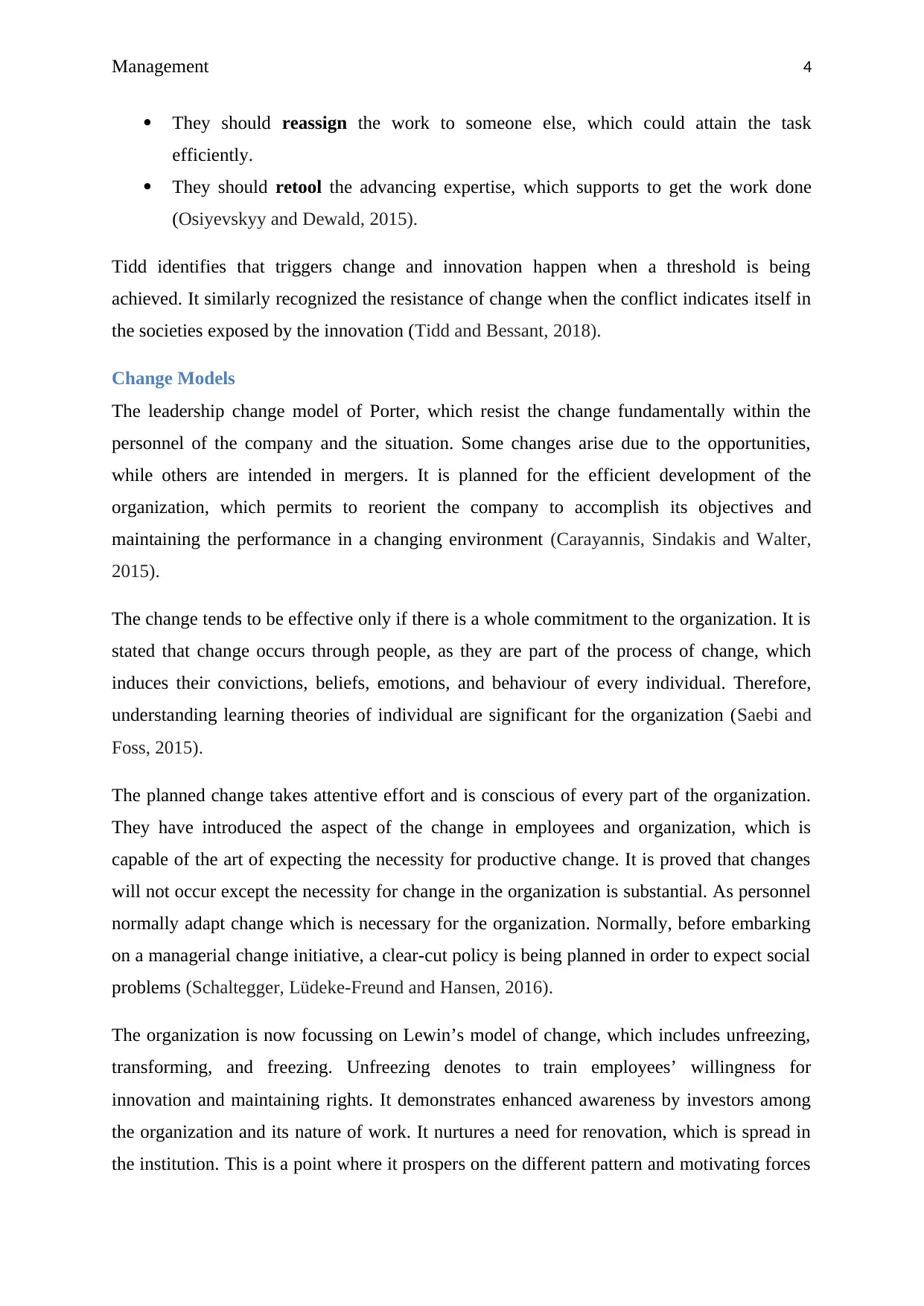
Management 4
They should reassign the work to someone else, which could attain the task
efficiently.
They should retool the advancing expertise, which supports to get the work done
(Osiyevskyy and Dewald, 2015).
Tidd identifies that triggers change and innovation happen when a threshold is being
achieved. It similarly recognized the resistance of change when the conflict indicates itself in
the societies exposed by the innovation (Tidd and Bessant, 2018).
Change Models
The leadership change model of Porter, which resist the change fundamentally within the
personnel of the company and the situation. Some changes arise due to the opportunities,
while others are intended in mergers. It is planned for the efficient development of the
organization, which permits to reorient the company to accomplish its objectives and
maintaining the performance in a changing environment (Carayannis, Sindakis and Walter,
2015).
The change tends to be effective only if there is a whole commitment to the organization. It is
stated that change occurs through people, as they are part of the process of change, which
induces their convictions, beliefs, emotions, and behaviour of every individual. Therefore,
understanding learning theories of individual are significant for the organization (Saebi and
Foss, 2015).
The planned change takes attentive effort and is conscious of every part of the organization.
They have introduced the aspect of the change in employees and organization, which is
capable of the art of expecting the necessity for productive change. It is proved that changes
will not occur except the necessity for change in the organization is substantial. As personnel
normally adapt change which is necessary for the organization. Normally, before embarking
on a managerial change initiative, a clear-cut policy is being planned in order to expect social
problems (Schaltegger, Lüdeke-Freund and Hansen, 2016).
The organization is now focussing on Lewin’s model of change, which includes unfreezing,
transforming, and freezing. Unfreezing denotes to train employees’ willingness for
innovation and maintaining rights. It demonstrates enhanced awareness by investors among
the organization and its nature of work. It nurtures a need for renovation, which is spread in
the institution. This is a point where it prospers on the different pattern and motivating forces
They should reassign the work to someone else, which could attain the task
efficiently.
They should retool the advancing expertise, which supports to get the work done
(Osiyevskyy and Dewald, 2015).
Tidd identifies that triggers change and innovation happen when a threshold is being
achieved. It similarly recognized the resistance of change when the conflict indicates itself in
the societies exposed by the innovation (Tidd and Bessant, 2018).
Change Models
The leadership change model of Porter, which resist the change fundamentally within the
personnel of the company and the situation. Some changes arise due to the opportunities,
while others are intended in mergers. It is planned for the efficient development of the
organization, which permits to reorient the company to accomplish its objectives and
maintaining the performance in a changing environment (Carayannis, Sindakis and Walter,
2015).
The change tends to be effective only if there is a whole commitment to the organization. It is
stated that change occurs through people, as they are part of the process of change, which
induces their convictions, beliefs, emotions, and behaviour of every individual. Therefore,
understanding learning theories of individual are significant for the organization (Saebi and
Foss, 2015).
The planned change takes attentive effort and is conscious of every part of the organization.
They have introduced the aspect of the change in employees and organization, which is
capable of the art of expecting the necessity for productive change. It is proved that changes
will not occur except the necessity for change in the organization is substantial. As personnel
normally adapt change which is necessary for the organization. Normally, before embarking
on a managerial change initiative, a clear-cut policy is being planned in order to expect social
problems (Schaltegger, Lüdeke-Freund and Hansen, 2016).
The organization is now focussing on Lewin’s model of change, which includes unfreezing,
transforming, and freezing. Unfreezing denotes to train employees’ willingness for
innovation and maintaining rights. It demonstrates enhanced awareness by investors among
the organization and its nature of work. It nurtures a need for renovation, which is spread in
the institution. This is a point where it prospers on the different pattern and motivating forces

Management 5
of perception. This phase is considered by a degree of uncertainty, instability, and loss of
landmark, which results in the sense of the necessity to change (Al-Haddad and Kotnour,
2015).
Through the transformation process, drive develops when stakeholders design its execution
and transform with the responsibility of people to embrace the innovation. In the last phase of
refreezing, people should identify and re-establish the equilibrium as individuals within the
company. In this last step, the method of innovation and change is the commencement of
advanced practices. It is, therefore, the alliance and acceptance of changed behaviour.
Additionally, throughout this phase, the institutions should help the emergence of new beliefs
and root of new standards. It thus holds people to return to the previous step, and it will result
in progress (Bucciarelli, 2015).
The Lewin’s model of force field analysis reflects that a concern is to be made to the
connection between two conflicting sets of forces i.e. positive and negative. It is considered
that positive forces are to be termed as driving change and negative forces are to be termed as
restraining change. They consider an extent of driving forces that assist with a set of
restraining forces that compete and balance it. In addition, it permits Lewin to continuity and
discontinuity within group behaviour. In this regard, behavioural change is not perceived of
as developing needing the involvement of a ‘change agent’. This descriptive model has some
restrictions, which fails to define the emotional state of an individual during the change
management of the organization. It depends upon the change agent to act as an
interconnection among states of permanency while assisting to maintain resistance to change.
It is being stated that not every people or stakeholder will settle on the vision and mission and
afterward implement it (Rodríguez and Nieto, 2016).
It is to be critically evaluated that Organizational change theory of Ben Smith, which
discusses these forces, may incorporate the organizational structure, personnel, and
management. It indicates that effectiveness and sustainability can be maximized by
organizational change.
Another risky constraint is to be stated to move a step back in initial phases where
modernizing may be essential. Another model of innovation and change model is Kotter’s
model of change. It develops a sense of determination and forms a strong coalition by
generating and sharing the vision to other people. They should encourage others to act upon
the mission through planning, generating short-term wins, and joining developments, and
of perception. This phase is considered by a degree of uncertainty, instability, and loss of
landmark, which results in the sense of the necessity to change (Al-Haddad and Kotnour,
2015).
Through the transformation process, drive develops when stakeholders design its execution
and transform with the responsibility of people to embrace the innovation. In the last phase of
refreezing, people should identify and re-establish the equilibrium as individuals within the
company. In this last step, the method of innovation and change is the commencement of
advanced practices. It is, therefore, the alliance and acceptance of changed behaviour.
Additionally, throughout this phase, the institutions should help the emergence of new beliefs
and root of new standards. It thus holds people to return to the previous step, and it will result
in progress (Bucciarelli, 2015).
The Lewin’s model of force field analysis reflects that a concern is to be made to the
connection between two conflicting sets of forces i.e. positive and negative. It is considered
that positive forces are to be termed as driving change and negative forces are to be termed as
restraining change. They consider an extent of driving forces that assist with a set of
restraining forces that compete and balance it. In addition, it permits Lewin to continuity and
discontinuity within group behaviour. In this regard, behavioural change is not perceived of
as developing needing the involvement of a ‘change agent’. This descriptive model has some
restrictions, which fails to define the emotional state of an individual during the change
management of the organization. It depends upon the change agent to act as an
interconnection among states of permanency while assisting to maintain resistance to change.
It is being stated that not every people or stakeholder will settle on the vision and mission and
afterward implement it (Rodríguez and Nieto, 2016).
It is to be critically evaluated that Organizational change theory of Ben Smith, which
discusses these forces, may incorporate the organizational structure, personnel, and
management. It indicates that effectiveness and sustainability can be maximized by
organizational change.
Another risky constraint is to be stated to move a step back in initial phases where
modernizing may be essential. Another model of innovation and change model is Kotter’s
model of change. It develops a sense of determination and forms a strong coalition by
generating and sharing the vision to other people. They should encourage others to act upon
the mission through planning, generating short-term wins, and joining developments, and
⊘ This is a preview!⊘
Do you want full access?
Subscribe today to unlock all pages.

Trusted by 1+ million students worldwide
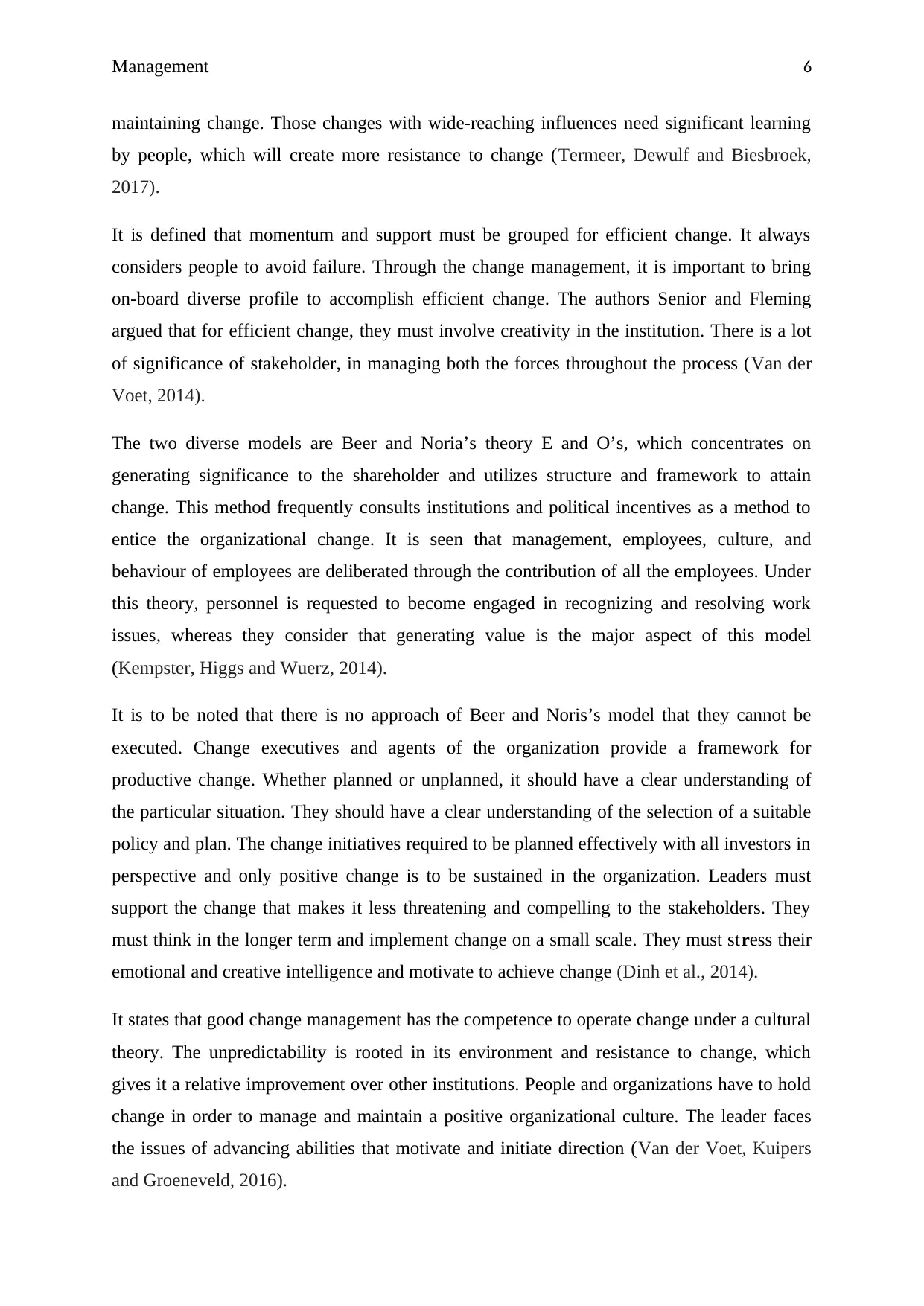
Management 6
maintaining change. Those changes with wide-reaching influences need significant learning
by people, which will create more resistance to change (Termeer, Dewulf and Biesbroek,
2017).
It is defined that momentum and support must be grouped for efficient change. It always
considers people to avoid failure. Through the change management, it is important to bring
on-board diverse profile to accomplish efficient change. The authors Senior and Fleming
argued that for efficient change, they must involve creativity in the institution. There is a lot
of significance of stakeholder, in managing both the forces throughout the process (Van der
Voet, 2014).
The two diverse models are Beer and Noria’s theory E and O’s, which concentrates on
generating significance to the shareholder and utilizes structure and framework to attain
change. This method frequently consults institutions and political incentives as a method to
entice the organizational change. It is seen that management, employees, culture, and
behaviour of employees are deliberated through the contribution of all the employees. Under
this theory, personnel is requested to become engaged in recognizing and resolving work
issues, whereas they consider that generating value is the major aspect of this model
(Kempster, Higgs and Wuerz, 2014).
It is to be noted that there is no approach of Beer and Noris’s model that they cannot be
executed. Change executives and agents of the organization provide a framework for
productive change. Whether planned or unplanned, it should have a clear understanding of
the particular situation. They should have a clear understanding of the selection of a suitable
policy and plan. The change initiatives required to be planned effectively with all investors in
perspective and only positive change is to be sustained in the organization. Leaders must
support the change that makes it less threatening and compelling to the stakeholders. They
must think in the longer term and implement change on a small scale. They must stress their
emotional and creative intelligence and motivate to achieve change (Dinh et al., 2014).
It states that good change management has the competence to operate change under a cultural
theory. The unpredictability is rooted in its environment and resistance to change, which
gives it a relative improvement over other institutions. People and organizations have to hold
change in order to manage and maintain a positive organizational culture. The leader faces
the issues of advancing abilities that motivate and initiate direction (Van der Voet, Kuipers
and Groeneveld, 2016).
maintaining change. Those changes with wide-reaching influences need significant learning
by people, which will create more resistance to change (Termeer, Dewulf and Biesbroek,
2017).
It is defined that momentum and support must be grouped for efficient change. It always
considers people to avoid failure. Through the change management, it is important to bring
on-board diverse profile to accomplish efficient change. The authors Senior and Fleming
argued that for efficient change, they must involve creativity in the institution. There is a lot
of significance of stakeholder, in managing both the forces throughout the process (Van der
Voet, 2014).
The two diverse models are Beer and Noria’s theory E and O’s, which concentrates on
generating significance to the shareholder and utilizes structure and framework to attain
change. This method frequently consults institutions and political incentives as a method to
entice the organizational change. It is seen that management, employees, culture, and
behaviour of employees are deliberated through the contribution of all the employees. Under
this theory, personnel is requested to become engaged in recognizing and resolving work
issues, whereas they consider that generating value is the major aspect of this model
(Kempster, Higgs and Wuerz, 2014).
It is to be noted that there is no approach of Beer and Noris’s model that they cannot be
executed. Change executives and agents of the organization provide a framework for
productive change. Whether planned or unplanned, it should have a clear understanding of
the particular situation. They should have a clear understanding of the selection of a suitable
policy and plan. The change initiatives required to be planned effectively with all investors in
perspective and only positive change is to be sustained in the organization. Leaders must
support the change that makes it less threatening and compelling to the stakeholders. They
must think in the longer term and implement change on a small scale. They must stress their
emotional and creative intelligence and motivate to achieve change (Dinh et al., 2014).
It states that good change management has the competence to operate change under a cultural
theory. The unpredictability is rooted in its environment and resistance to change, which
gives it a relative improvement over other institutions. People and organizations have to hold
change in order to manage and maintain a positive organizational culture. The leader faces
the issues of advancing abilities that motivate and initiate direction (Van der Voet, Kuipers
and Groeneveld, 2016).
Paraphrase This Document
Need a fresh take? Get an instant paraphrase of this document with our AI Paraphraser
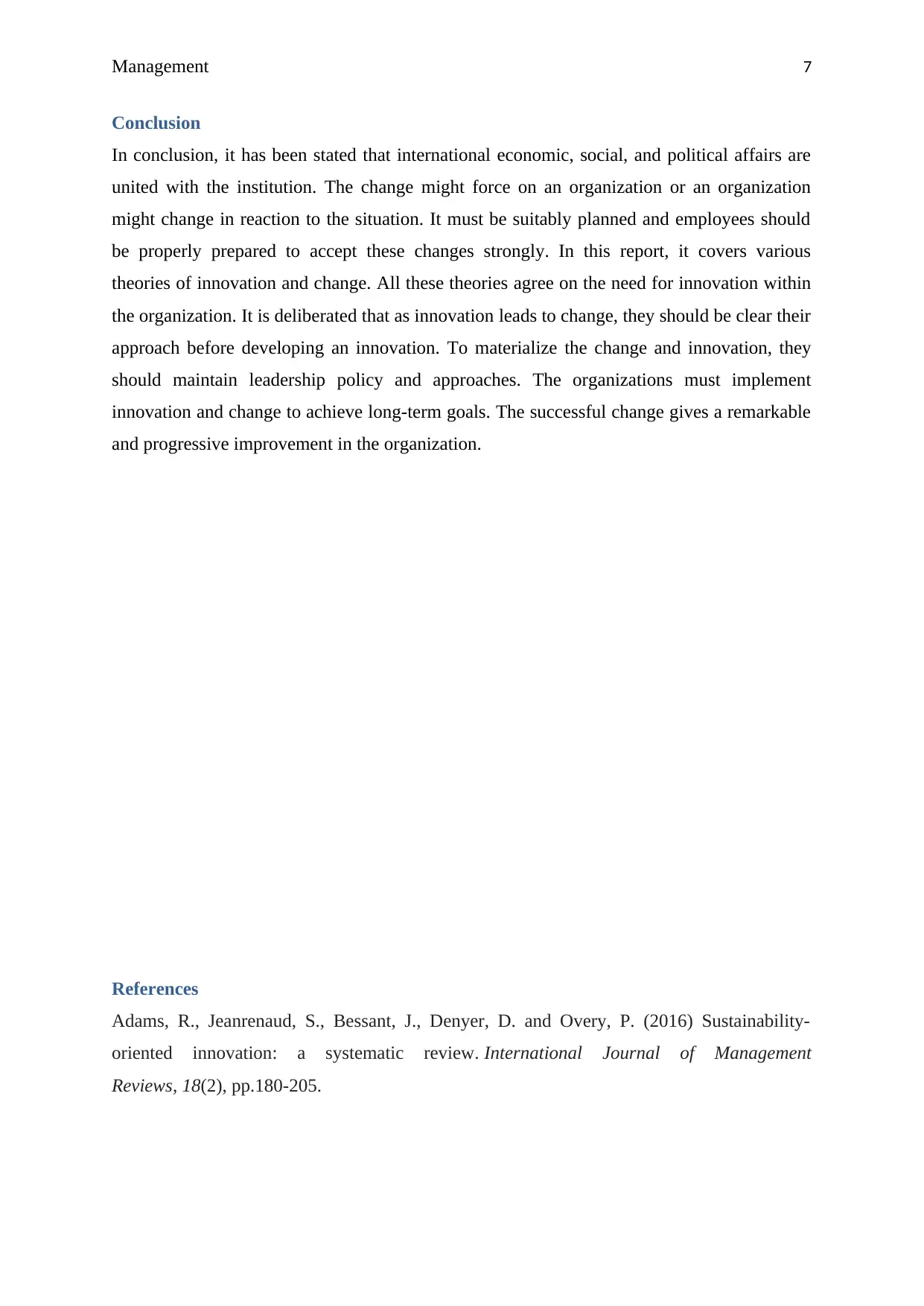
Management 7
Conclusion
In conclusion, it has been stated that international economic, social, and political affairs are
united with the institution. The change might force on an organization or an organization
might change in reaction to the situation. It must be suitably planned and employees should
be properly prepared to accept these changes strongly. In this report, it covers various
theories of innovation and change. All these theories agree on the need for innovation within
the organization. It is deliberated that as innovation leads to change, they should be clear their
approach before developing an innovation. To materialize the change and innovation, they
should maintain leadership policy and approaches. The organizations must implement
innovation and change to achieve long-term goals. The successful change gives a remarkable
and progressive improvement in the organization.
References
Adams, R., Jeanrenaud, S., Bessant, J., Denyer, D. and Overy, P. (2016) Sustainability‐
oriented innovation: a systematic review. International Journal of Management
Reviews, 18(2), pp.180-205.
Conclusion
In conclusion, it has been stated that international economic, social, and political affairs are
united with the institution. The change might force on an organization or an organization
might change in reaction to the situation. It must be suitably planned and employees should
be properly prepared to accept these changes strongly. In this report, it covers various
theories of innovation and change. All these theories agree on the need for innovation within
the organization. It is deliberated that as innovation leads to change, they should be clear their
approach before developing an innovation. To materialize the change and innovation, they
should maintain leadership policy and approaches. The organizations must implement
innovation and change to achieve long-term goals. The successful change gives a remarkable
and progressive improvement in the organization.
References
Adams, R., Jeanrenaud, S., Bessant, J., Denyer, D. and Overy, P. (2016) Sustainability‐
oriented innovation: a systematic review. International Journal of Management
Reviews, 18(2), pp.180-205.
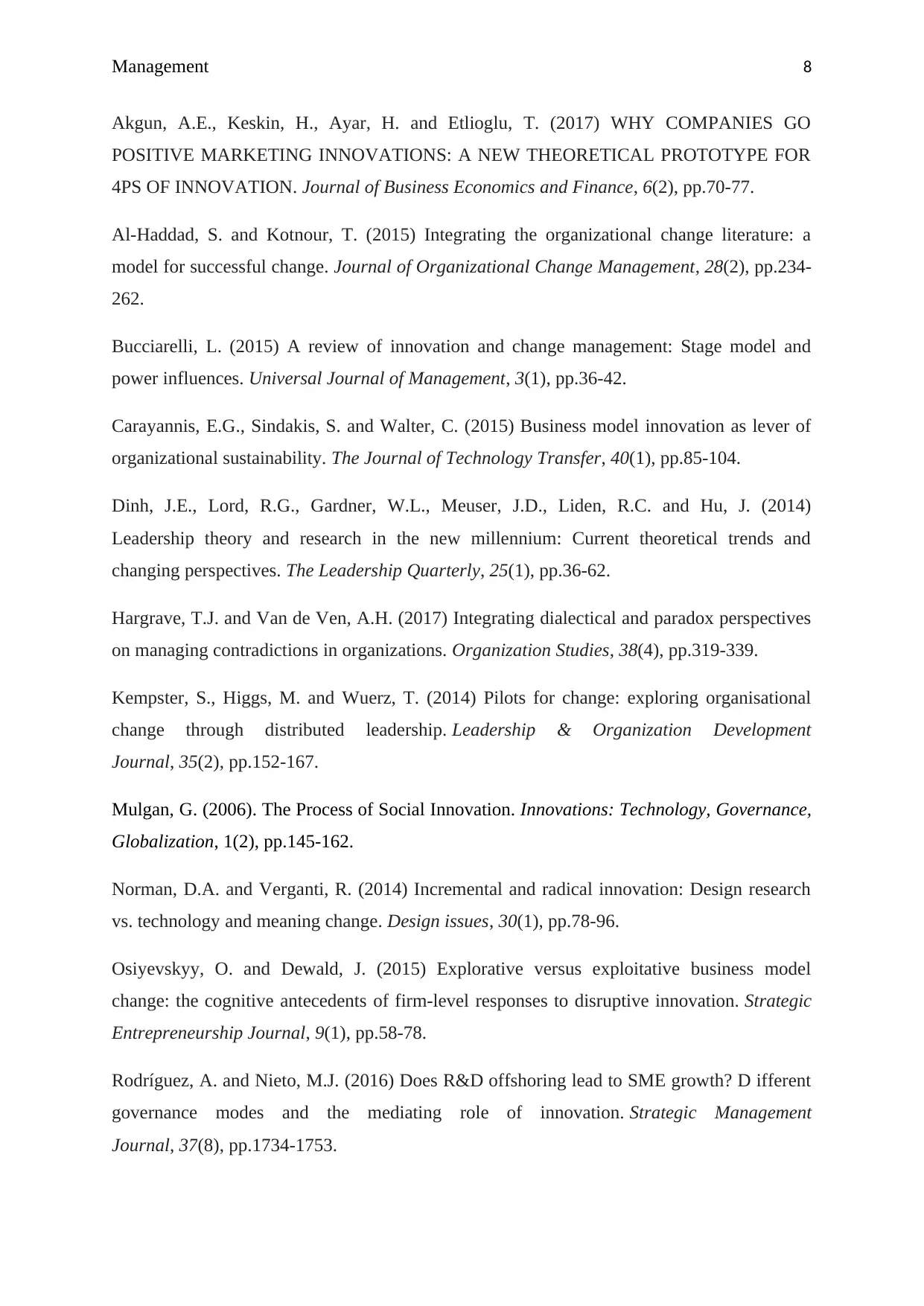
Management 8
Akgun, A.E., Keskin, H., Ayar, H. and Etlioglu, T. (2017) WHY COMPANIES GO
POSITIVE MARKETING INNOVATIONS: A NEW THEORETICAL PROTOTYPE FOR
4PS OF INNOVATION. Journal of Business Economics and Finance, 6(2), pp.70-77.
Al-Haddad, S. and Kotnour, T. (2015) Integrating the organizational change literature: a
model for successful change. Journal of Organizational Change Management, 28(2), pp.234-
262.
Bucciarelli, L. (2015) A review of innovation and change management: Stage model and
power influences. Universal Journal of Management, 3(1), pp.36-42.
Carayannis, E.G., Sindakis, S. and Walter, C. (2015) Business model innovation as lever of
organizational sustainability. The Journal of Technology Transfer, 40(1), pp.85-104.
Dinh, J.E., Lord, R.G., Gardner, W.L., Meuser, J.D., Liden, R.C. and Hu, J. (2014)
Leadership theory and research in the new millennium: Current theoretical trends and
changing perspectives. The Leadership Quarterly, 25(1), pp.36-62.
Hargrave, T.J. and Van de Ven, A.H. (2017) Integrating dialectical and paradox perspectives
on managing contradictions in organizations. Organization Studies, 38(4), pp.319-339.
Kempster, S., Higgs, M. and Wuerz, T. (2014) Pilots for change: exploring organisational
change through distributed leadership. Leadership & Organization Development
Journal, 35(2), pp.152-167.
Mulgan, G. (2006). The Process of Social Innovation. Innovations: Technology, Governance,
Globalization, 1(2), pp.145-162.
Norman, D.A. and Verganti, R. (2014) Incremental and radical innovation: Design research
vs. technology and meaning change. Design issues, 30(1), pp.78-96.
Osiyevskyy, O. and Dewald, J. (2015) Explorative versus exploitative business model
change: the cognitive antecedents of firm‐level responses to disruptive innovation. Strategic
Entrepreneurship Journal, 9(1), pp.58-78.
Rodríguez, A. and Nieto, M.J. (2016) Does R&D offshoring lead to SME growth? D ifferent
governance modes and the mediating role of innovation. Strategic Management
Journal, 37(8), pp.1734-1753.
Akgun, A.E., Keskin, H., Ayar, H. and Etlioglu, T. (2017) WHY COMPANIES GO
POSITIVE MARKETING INNOVATIONS: A NEW THEORETICAL PROTOTYPE FOR
4PS OF INNOVATION. Journal of Business Economics and Finance, 6(2), pp.70-77.
Al-Haddad, S. and Kotnour, T. (2015) Integrating the organizational change literature: a
model for successful change. Journal of Organizational Change Management, 28(2), pp.234-
262.
Bucciarelli, L. (2015) A review of innovation and change management: Stage model and
power influences. Universal Journal of Management, 3(1), pp.36-42.
Carayannis, E.G., Sindakis, S. and Walter, C. (2015) Business model innovation as lever of
organizational sustainability. The Journal of Technology Transfer, 40(1), pp.85-104.
Dinh, J.E., Lord, R.G., Gardner, W.L., Meuser, J.D., Liden, R.C. and Hu, J. (2014)
Leadership theory and research in the new millennium: Current theoretical trends and
changing perspectives. The Leadership Quarterly, 25(1), pp.36-62.
Hargrave, T.J. and Van de Ven, A.H. (2017) Integrating dialectical and paradox perspectives
on managing contradictions in organizations. Organization Studies, 38(4), pp.319-339.
Kempster, S., Higgs, M. and Wuerz, T. (2014) Pilots for change: exploring organisational
change through distributed leadership. Leadership & Organization Development
Journal, 35(2), pp.152-167.
Mulgan, G. (2006). The Process of Social Innovation. Innovations: Technology, Governance,
Globalization, 1(2), pp.145-162.
Norman, D.A. and Verganti, R. (2014) Incremental and radical innovation: Design research
vs. technology and meaning change. Design issues, 30(1), pp.78-96.
Osiyevskyy, O. and Dewald, J. (2015) Explorative versus exploitative business model
change: the cognitive antecedents of firm‐level responses to disruptive innovation. Strategic
Entrepreneurship Journal, 9(1), pp.58-78.
Rodríguez, A. and Nieto, M.J. (2016) Does R&D offshoring lead to SME growth? D ifferent
governance modes and the mediating role of innovation. Strategic Management
Journal, 37(8), pp.1734-1753.
⊘ This is a preview!⊘
Do you want full access?
Subscribe today to unlock all pages.

Trusted by 1+ million students worldwide
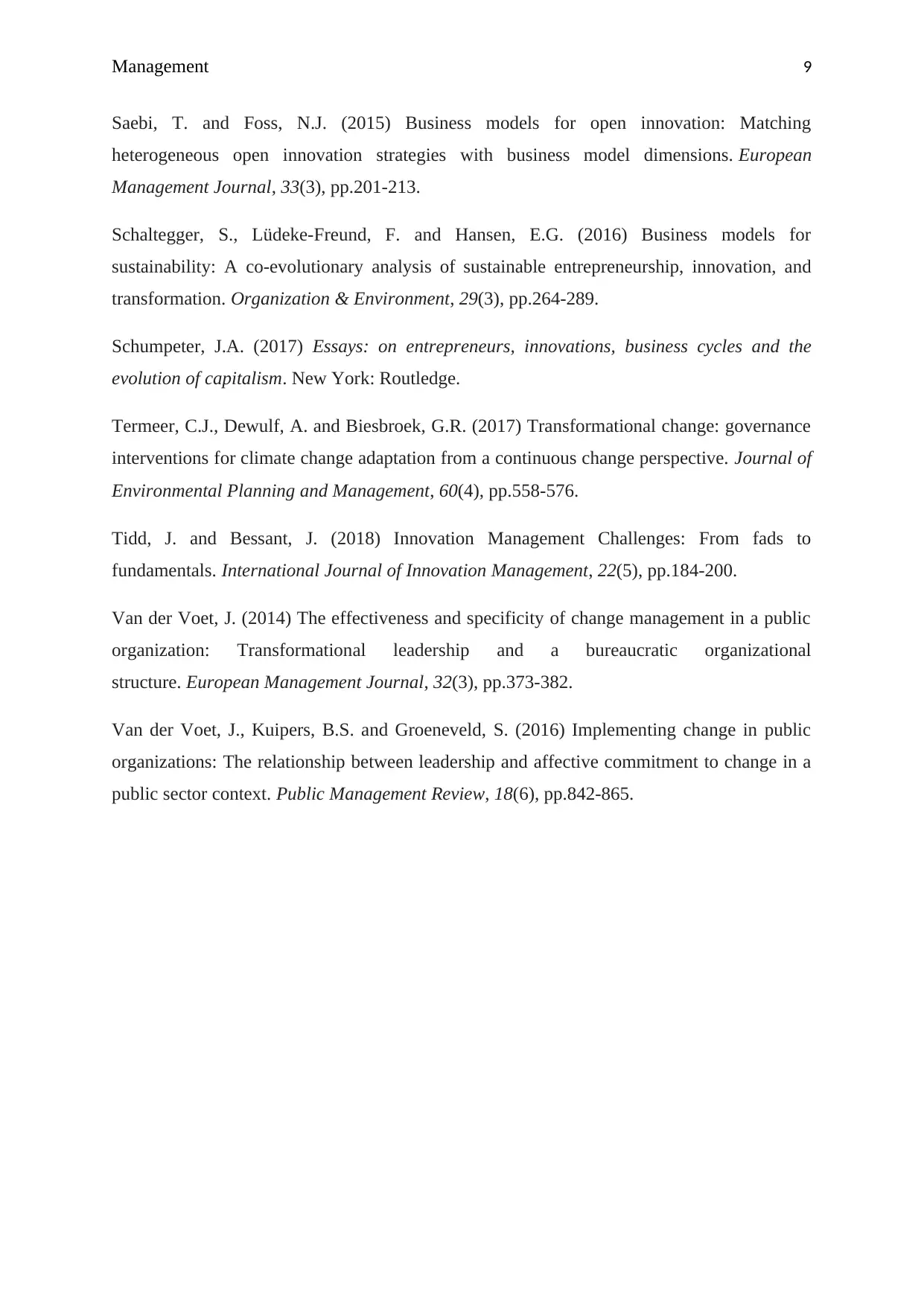
Management 9
Saebi, T. and Foss, N.J. (2015) Business models for open innovation: Matching
heterogeneous open innovation strategies with business model dimensions. European
Management Journal, 33(3), pp.201-213.
Schaltegger, S., Lüdeke-Freund, F. and Hansen, E.G. (2016) Business models for
sustainability: A co-evolutionary analysis of sustainable entrepreneurship, innovation, and
transformation. Organization & Environment, 29(3), pp.264-289.
Schumpeter, J.A. (2017) Essays: on entrepreneurs, innovations, business cycles and the
evolution of capitalism. New York: Routledge.
Termeer, C.J., Dewulf, A. and Biesbroek, G.R. (2017) Transformational change: governance
interventions for climate change adaptation from a continuous change perspective. Journal of
Environmental Planning and Management, 60(4), pp.558-576.
Tidd, J. and Bessant, J. (2018) Innovation Management Challenges: From fads to
fundamentals. International Journal of Innovation Management, 22(5), pp.184-200.
Van der Voet, J. (2014) The effectiveness and specificity of change management in a public
organization: Transformational leadership and a bureaucratic organizational
structure. European Management Journal, 32(3), pp.373-382.
Van der Voet, J., Kuipers, B.S. and Groeneveld, S. (2016) Implementing change in public
organizations: The relationship between leadership and affective commitment to change in a
public sector context. Public Management Review, 18(6), pp.842-865.
Saebi, T. and Foss, N.J. (2015) Business models for open innovation: Matching
heterogeneous open innovation strategies with business model dimensions. European
Management Journal, 33(3), pp.201-213.
Schaltegger, S., Lüdeke-Freund, F. and Hansen, E.G. (2016) Business models for
sustainability: A co-evolutionary analysis of sustainable entrepreneurship, innovation, and
transformation. Organization & Environment, 29(3), pp.264-289.
Schumpeter, J.A. (2017) Essays: on entrepreneurs, innovations, business cycles and the
evolution of capitalism. New York: Routledge.
Termeer, C.J., Dewulf, A. and Biesbroek, G.R. (2017) Transformational change: governance
interventions for climate change adaptation from a continuous change perspective. Journal of
Environmental Planning and Management, 60(4), pp.558-576.
Tidd, J. and Bessant, J. (2018) Innovation Management Challenges: From fads to
fundamentals. International Journal of Innovation Management, 22(5), pp.184-200.
Van der Voet, J. (2014) The effectiveness and specificity of change management in a public
organization: Transformational leadership and a bureaucratic organizational
structure. European Management Journal, 32(3), pp.373-382.
Van der Voet, J., Kuipers, B.S. and Groeneveld, S. (2016) Implementing change in public
organizations: The relationship between leadership and affective commitment to change in a
public sector context. Public Management Review, 18(6), pp.842-865.
1 out of 10
Related Documents
Your All-in-One AI-Powered Toolkit for Academic Success.
+13062052269
info@desklib.com
Available 24*7 on WhatsApp / Email
![[object Object]](/_next/static/media/star-bottom.7253800d.svg)
Unlock your academic potential
Copyright © 2020–2025 A2Z Services. All Rights Reserved. Developed and managed by ZUCOL.





